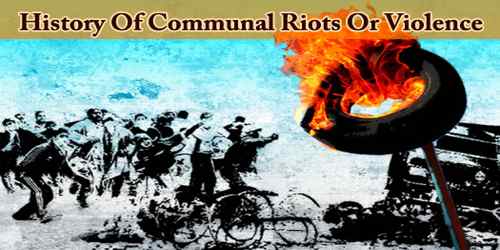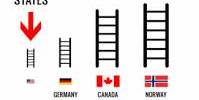Communal Violence or Riots involves people belonging to two different religious communities mobilized against each other and carrying the feelings of hostility, emotional fury, exploitation, social discrimination, and social neglect. The high degree of cohesion in one community against another is built around tension and polarization. The targets of attack are the members of the ‘enemy’ community. Generally, there is no leadership in communal riots which could effectively control and contain the riot situation. It could thus be said that communal violence is based mainly on hatred, enmity, and revenge. Communal violence is found in Africa, the Americas, Asia, Europe, and Australia.
United Nations Office on Drugs and Crime includes any conflict and form of violence between communities of the different religious groups, different sects or tribes of the same religious group, clans, ethnic origins or national origin as communal violence. However, this excludes conflict between two individuals or two families.
Communal violence has increased quantitatively and qualitatively ever since politics came to be communalized. The term was constructed by the British colonial authorities as it wrestled to manage violence between religious, ethnic and disparate groups in its colonies, particularly Africa and South Asia, in the early 20th century.
Communal violence, in different parts of the world, is alternatively referred to as ethnic violence, non-State conflict, violent civil unrest, minorities unrest, mass racial violence, inter-communal violence, and ethnoreligious violence.
History –
In the twentieth century alone, over 250 formally declared wars took over 100 million lives. Undeclared wars, including political repression, communal violence, and genocide took millions more; for example, between 50 and 100 million people have been killed by forces and citizens of states in the twentieth century because of their socio-cultural and ethnic belongings. If we expand the definition of war to include such armed conflicts as gang warfare, ‘the war on drugs’ and, more recently, ‘the war on terror,’ casualties figures rise, though accurate statistics are not available on these forms of violence.
Europe and Africa – Human history has experienced numerous episodes of communal violence. For example, in medieval Europe, Protestants clashed with Catholics, Christians clashed with Muslims while both perpetuated violence against Jews and Roma minorities. In 1561, Huguenots in Toulouse took out in a procession through the streets to express their solidarity for Protestant ideas. A few days later, the Catholics hunted down some of the leaders of the procession, beat them and burned them at the stake. In the French town of Pamiers, communal clashes were routine between Protestants and Catholics, such as during holy celebrations where the Catholics took out a procession with a statue of St. Anthony, sang and danced while they carried the statue around town. Local Protestants would year after year disrupt the festivities by throwing stones at the Catholics. In 1566, when the Catholic procession reached a Protestant neighborhood, the Protestants chanted “kill, kill, kill !!” and days of communal violence with numerous fatalities followed. In 1572, thousands of Protestants were killed by Catholics during communal violence in each of the following cities Paris, Aix, Bordeaux, Bourges, Lyon, Meaux, Orleans, Rouen, Toulouse, and Troyes. In Switzerland, communal violence between the Reformation movement and Catholics marked the 16th century.
Asia – East, South and Southeast Asia have recorded numerous instances of communal violence. For example, Singapore suffered a wave of communal violence in 20th century between Malays and Chinese. In Indian subcontinent, numerous 18th through 20th century records of the British colonial era mention communal violence between Hindus and Muslims, as well as Sunni and Shia sects of Islam, particularly during processions related to respective religious celebrations. Small incidents sometimes lead to big riots which result in a large scale violence, loot and arson. They have always resulted in a lot of bloodshed and destruction. Man becomes a wolf to man and is out to kill and destroy. The various state and central governments have been doing their best to put such riots down with an iron hand but they continue to raise their ugly head at various times at various places.
Such outbursts of violence have been on the increase in the county in the recent past. Clashes between different communities, economic groups, and political parties are quite frequent. They not only result in a great loss to national life and properly but also create a bad blood amongst different section of the people. All this poses a great danger to the unity and freedom of the country. Growing fissiparous tendencies in the country must be controlled on a top priority basis. This can be done only by inculcating a spirit of integration and oneness in the country. National integration is the crying need of the hour.
The frequency of communal violence in South Asia increased after the first partition of Bengal in 1905, where segregation, unequal political and economic rights were imposed on Hindus and Muslims by Lord Curzon, based on religion. The colonial rule was viewed by each side as favoring the other side, resulting in a wave of communal riots and 1911 reversal of Bengal partition and its re-unification.
In 1919, after British General Dyer ordered his soldiers to fire on unarmed protestors inside a compound in Amritsar, killing 380 civilians, communal violence followed in India against British settlements. There were hundreds of incidents of communal violence between 1905 and 1947, many related to religious, political sovereignty questions including partition of India along religious lines into East Pakistan, West Pakistan, and India. The 1946 to 1947 period saw some of the worst communal violence of 20th century, where waves of riots and violence killed between 100,000 and a million people, from Hindu, Muslim, Sikh and Jain religions, particularly in cities and towns near the modern borders of India-Pakistan and India-Bangladesh. Examples of these communal violence include the so-called Direct Action Day, Noakhali riots and the Partition riots in Rawalpindi.
The 20th century witnessed inter-religious, intra-religious and ethnic communal violence in the Middle East, South Russia, Eastern Europe, Central Asia, South Asia, and Southeast Asia.
Causes of Communal Violence: Different scholars have approached the problem of communal violence with different perspectives, attributing different causes and suggesting different measures to counter it. The Marxist school relates communalism to economic deprivation and to the class struggle between the haves and the have-not’s to secure a monopoly control of the market forces. Political scientists view it as a power struggle. Sociologists see it as a phenomenon of social tensions and relative deprivations. The religious experts perceive it as a diadem of violent fundamentalists and conformists.
The class analysis of communalism requires some attention. The explanation is that the economic, social and political situations in a society sometimes create such problems and crises for the people that even though they try to come to grips with these crises, they fail to do so. Without attempting to grasp the real causes for this failure, they ‘perceive’ the other community (numerically much stronger than their own) as the cause of their woes. Communalism is thus a social reality which is generated and reflected in a distorted way.
In China, the communal violence in Xinjiang province is called ethnic violence. Communal violence and riots have also been called non-State conflict, violent civil or minorities unrest, mass racial violence, social or inter-communal violence and ethno-religious violence.
Information Sources:
















